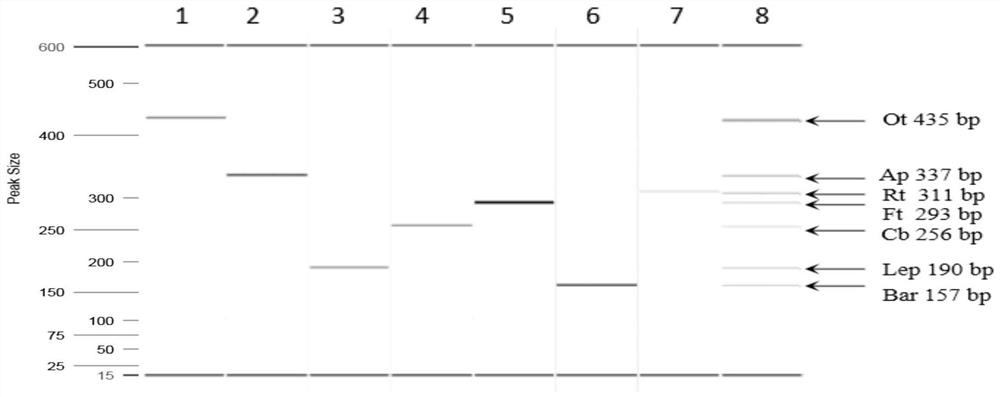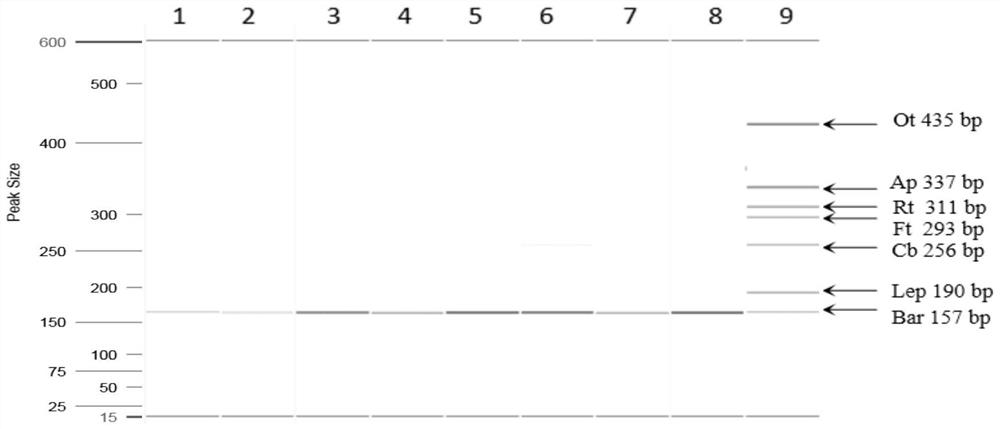PCR primer pair, kit and use thereof for pathogenic microorganisms with comonbid diseases in humans and mice
A technology of pathogenic microorganisms and primer pairs, applied in the field of microbiology, can solve the problems of low sensitivity, small operation throughput, and complicated operation.
- Summary
- Abstract
- Description
- Claims
- Application Information
AI Technical Summary
Problems solved by technology
Method used
Image
Examples
Embodiment 1
[0107] Example 1: Specific gene screening and primer design
[0108] On the microbial data analysis cloud platform (https: / / analysis.mypathogen.org), upload the target microorganisms Leptospira interrogans (GenBank accession number: AE010300.2), Rickettsia moschii (GenBank accession number: AE017197.1) ), Orientia tsutsugamushi (GenBank accession number: AM494475.1), Anaplasma phagocytophilum (GenBank accession number: CP000235.1), Francisella tularensis (GenBank accession number: AJ749949.2), Coxia basilica (GenBank accession number: AE016828.3) and Bartonella (GenBank accession number: BX897699.1) genome sequences, compared with other taxonomically similar microbial genome sequences and the gene coding sequences (coding sequences, CDS), select the "special marker gene" workflow to run, and obtain the specific gene of the target microorganism, wherein, the specific gene of Leptospira interrogans is the 99185th-100006th in the genome base sequence (referred to as the Lep speci...
Embodiment 2
[0116] Embodiment 2: establishment and optimization of multiplex PCR system
[0117] First establish a single-plex PCR reaction, the reaction system: 1 μl (1 μmol / L) of upstream and downstream chimeric primers CF and CR for one of the 7 kinds of microorganisms, 1 μl (10 μmol / L) of upstream and downstream general primers GF and GR (10 μmol / L), 2×master mix 12.5 μl, template 2 μl, ddH 2 O 6.5 μl. Reaction conditions: 95°C for 5 minutes; Stage 1: 95°C for 30s, 60°C for 1min, 72°C for 1min, cycle 10 times; Stage 2: 95°C for 30s, 69°C for 1min, 72°C for 1min, cycle 10 times; Stage 3: 95°C 30s, 45°C for 1min, 72°C for 1min, cycle 20 times; 72°C for 10min. Set up gradient PCR to optimize primer concentrations. On the basis of a single reaction, increase the primers sequentially, increase the number of reactions, and optimize the primer concentration, extension time and cycle number. The product was detected by QIAxcel capillary electrophoresis (the same below).
[0118] Taking t...
Embodiment 3
[0123] Embodiment 3: multiple PCR system specificity and sensitivity detection
[0124] The present invention designs 7 plasmid standard products in total, which are the recombinant plasmids containing the respective specific genes formed by inserting the respective specific genes used in Example 1 into T vectors, specifically: the specific genes of Ap, Cb, Bar, and Lep are inserted independently In the pUC57-Simple plasmid, the specific genes of Ot, Ft, and Rt were independently inserted into the pMD-19T-Simple plasmid to form respective recombinant plasmids. The mixed plasmids and mixed plasmid standard products mentioned in the present invention all refer to the mixture of these 7 plasmid standard products.
[0125] According to the conversion formula of copy number concentration: copy number concentration (copies / μl)=[DNA concentration (ng / μl) / base number×660]×6.02×10 23 , Dilute the plasmid standard by 10 times to 100-10 5 copies / μl.
[0126] (1) Multi-primer single-te...
PUM
 Login to View More
Login to View More Abstract
Description
Claims
Application Information
 Login to View More
Login to View More - R&D
- Intellectual Property
- Life Sciences
- Materials
- Tech Scout
- Unparalleled Data Quality
- Higher Quality Content
- 60% Fewer Hallucinations
Browse by: Latest US Patents, China's latest patents, Technical Efficacy Thesaurus, Application Domain, Technology Topic, Popular Technical Reports.
© 2025 PatSnap. All rights reserved.Legal|Privacy policy|Modern Slavery Act Transparency Statement|Sitemap|About US| Contact US: help@patsnap.com



